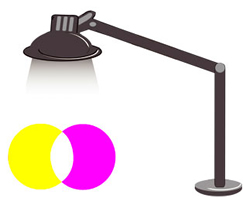What is Color?
Pure white light, such as sunlight, is composed of the visible colors. Sir Isaac Newton discovered this in 1666 by passing a beam of light through a prism.
The renowned English scientist was 23 years old at the time. He was made to stay home from Cambridge University for over a year because the plague that was sweeping Europe had closed it down. It was during this period that Newton performed his famous spectrum experiments. To alleviate the boredom of quarantine, he punched holes in the curtains of his darkened room to study the effects of light passing through a prism.
The light separated into the same progression of colors found in the natural rainbow.
Although he found an infinite number of colors in this spectrum, Newton wanted to show that there were just seven main colors, like the seven known planets and the seven musical notes in the diatonic scale. He identified red, orange, yellow, green, blue, indigo and violet. This was also in keeping with Aristotle's seven classes of color which he thought were all mixes of black and white.
Using a second prism, Newton showed that each color in the spectrum is monochromatic--that is, composed of a single, unique wavelength which can't be further separated into other colors.
Newton's experiments showed that light can be combined to form different colors. For example, combining blue and yellow light produces a green light that appears identical to the pure green found in a prism spectrum. (Modern techniques, however, show these greens to be two very different colors. Such color pairs are called metamers because they appear to be identical even though they have different wavelengths.)
Using two prisms, Newton found that some color combinations produce pure white instead of colored light. In effect, they complete each other when mixed. These pairs of colors are called complements. In this example you see that purple and yellow lights combine to form white.

